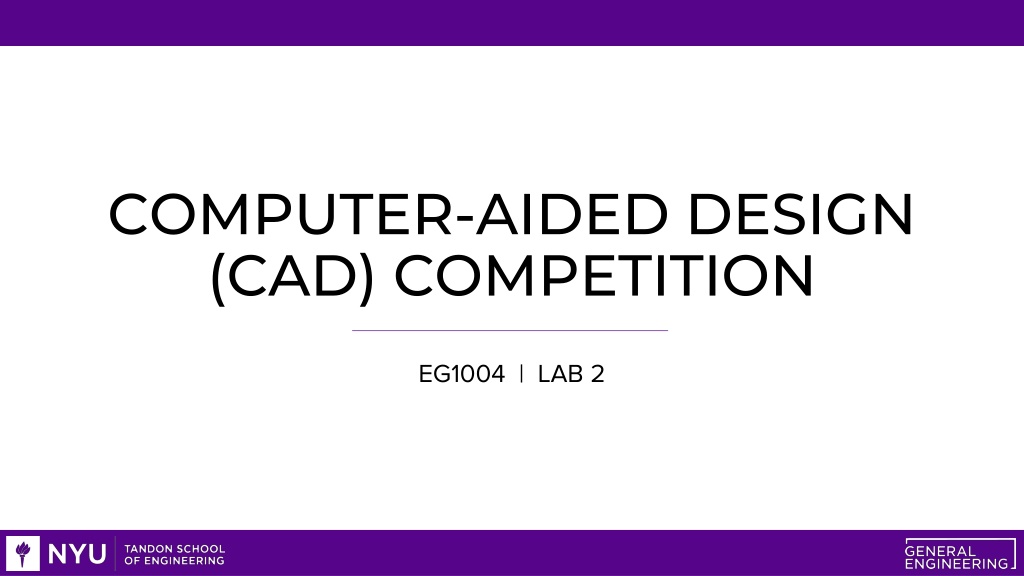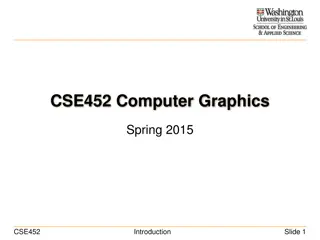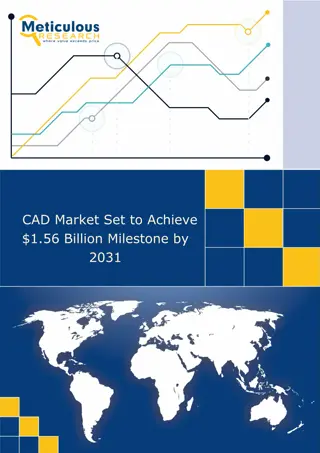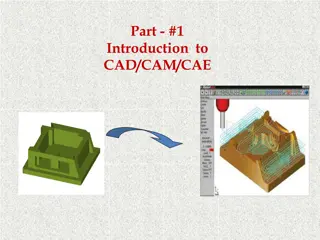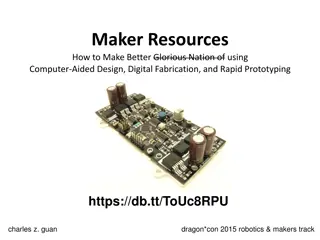Computer-Aided Design (CAD) Competition Overview
Explore the world of Computer-Aided Design through a competition utilizing Fusion 360 software to modify and enhance designs. Learn about IDBE implementation, conflict resolution, and inclusive leadership in the context of CAD. Gain insights into design workspace tools like Extrude, Sweep, and Loft for 3D modeling. Discover the significance of 3D printing and Cura in rapid prototyping. Dive into simulations for structural analysis and real-world conditions.
Download Presentation

Please find below an Image/Link to download the presentation.
The content on the website is provided AS IS for your information and personal use only. It may not be sold, licensed, or shared on other websites without obtaining consent from the author.If you encounter any issues during the download, it is possible that the publisher has removed the file from their server.
You are allowed to download the files provided on this website for personal or commercial use, subject to the condition that they are used lawfully. All files are the property of their respective owners.
The content on the website is provided AS IS for your information and personal use only. It may not be sold, licensed, or shared on other websites without obtaining consent from the author.
E N D
Presentation Transcript
COMPUTER-AIDED DESIGN (CAD) COMPETITION EG1004 | LAB 2
OVERVIEW Objective IDBE Implementation Background Information Materials Procedure Competition Rules Assignment Closing Figure 1: Fusion 360 (Left) and Cura (Right) Courtesy of AppRecs and Wikipedia 1
OBJECTIVE Use CAD software, Fusion 360, to modify a design Analyze and modify a poorly-designed part in Fusion 360 Enter the modified part in a competition against other redesigns 2
IDBE IMPLEMENTATION Inclusive Leadership Effective and inclusive leaders work to identify their peers strengths and support their weaknesses Our social identities play an important role in how we lead and the ways we can relate to others Conflict Resolution How do you approach an interpersonal conflict? What expectations do you have for your team members? Are these realistic expectations? How can we make our emotions and the emotions of others heard? Figure 2: Inclusive Leadership from Deloitte 3
BACKGROUND Fusion 360 Computer-Aided Design (CAD) software Creates 3D drawings of engineering designs Also used for CAM, rendering, simulation, etc. 3D printing allows for rapid prototyping and onsite manufacturing Cura 3D printing preparation application Figure 3: Fusion 360 in use courtesy of Autodesk 4
BACKGROUND INFORMATION Design workspace Used to make precisely- scaled drawings of engineering designs Sketch a 2D profile Generate 3D body using Extrude, Sweep, or Loft Figure 4: Extrude and Sweep tools 5
BACKGROUND INFORMATION Loft Creates a 3D extrusion to connect two profiles Sweep Creates a 3D model of a surface (profile) along a specific path Figure 3: Extrude and Sweep tools 6
BACKGROUND INFORMATION Simulation workspace Used to run structural analysis on model under real-world conditions Define the constraints (boundary conditions) on the model Apply a load to simulate real-world force Generate a mesh, an array of polygons making up the body of the model Figure 5: Fusion 360 mesh courtesy of O Reilly 7
BACKGROUND INFORMATION Simulation workspace Run simulation to obtain safety factor, a value used to describe how much stronger a system is than the expected load Can determine if an object is ready to sustain real-world loads or needs to be remodified Figure 6: Fusion 360 simulation courtesy of Engineering.com 8
MATERIALS A lab PC Fusion 360 Predesigned part files (download directly from the manual) Figure 7: Truss Pyramid 9
PROCEDURE Part 1: Set up the File Part 2: Learning Exercise Simultaneous activity with TAs Figure 8: Redesigned Part 10
PROCEDURE Part 3: CAD Competition Find the load, material, and constraints on the model Run a static stress simulation Review the initial factor of safety Modify the model in the Design workspace within the limits of the competition rules Rerun simulations and remodify until the part has safety factor of at least 3 Save and store the F3D file for later use Figure 9: Screwed bracket static stress simulation 11
COMPETITION RULES Redesigned part must be less than double the initial volume Redesigned part must have a safety factor of at least 3 Cannot alter the applied loads or constraints Cannot remove the areas highlighted in red on the model Can only use aluminum, steel, copper, or lead Figure 10: Wire Supported Shelf 12
ASSIGNMENT Individual lab report: Answer discussion questions in manual Learning Exercise section need not be discussed Include screenshots of at least two simulations Due at 11:59 PM the night before Lab 3 Team presentation: Address discussion points in manual Learning Exercise section need not be discussed Include drawings (top, front, most detailed side, isometric) of unmodified and modified part Due at 11:59 PM the night before Recitation 3 13
LAB REPORT REMINDER CONTRIBUTION STATEMENTS Paragraph at the end of Conclusion Discuss the parts of the lab that you completed State the importance of these parts to the overall experiment Refer to the Sample Lab Report manual page under Writing Resources 14
LAB REPORT REMINDER EXAMPLE 15
CLOSING Have all original data signed by a TA Submit all work electronically Take screenshots of mechanical part before and after modification 16
